Leadership Strategies in Managing Organizational Change Processes
VerifiedAdded on 2023/05/28
|7
|2236
|118
Report
AI Summary
This report delves into the critical aspects of managing change within organizations. It addresses strategies to mitigate employee resistance, emphasizing the fear of the unknown and the importance of communication, participation, and stress management programs. The report highlights the pivotal role of leaders and change agents as sponsors, decision-makers, communicators, motivators, and those accountable for the change process. Furthermore, it explores how senior management can assess the success of change management strategies through organizational performance metrics (KPIs, ROI), individual performance measures (surveys, assessments), and change management performance metrics (communication effectiveness, project KPIs). The report underscores the need for a comprehensive approach to change management, incorporating both quantitative and qualitative assessments to ensure successful implementation and sustainable outcomes.
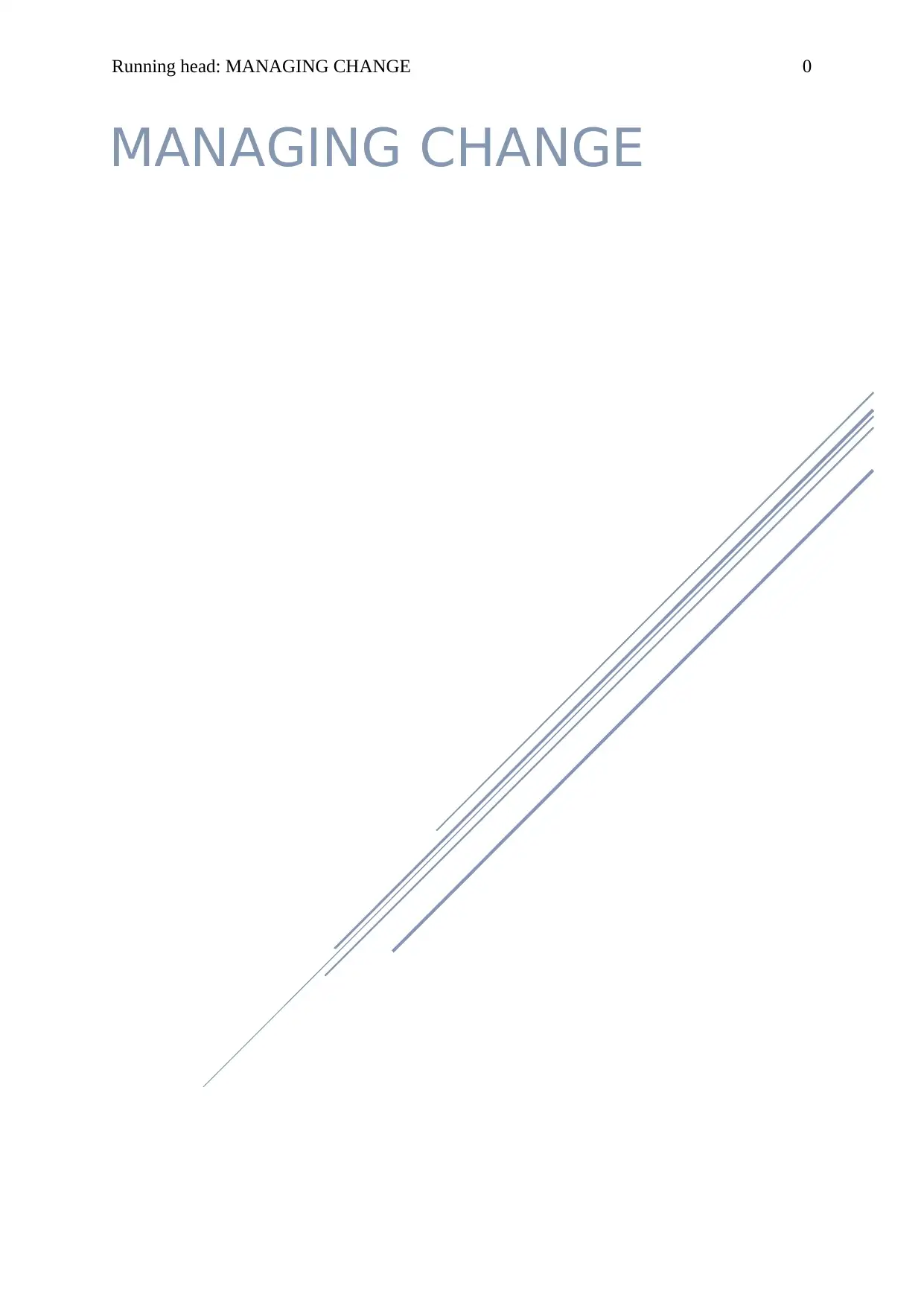
Running head: MANAGING CHANGE 0
MANAGING CHANGE
MANAGING CHANGE
Paraphrase This Document
Need a fresh take? Get an instant paraphrase of this document with our AI Paraphraser
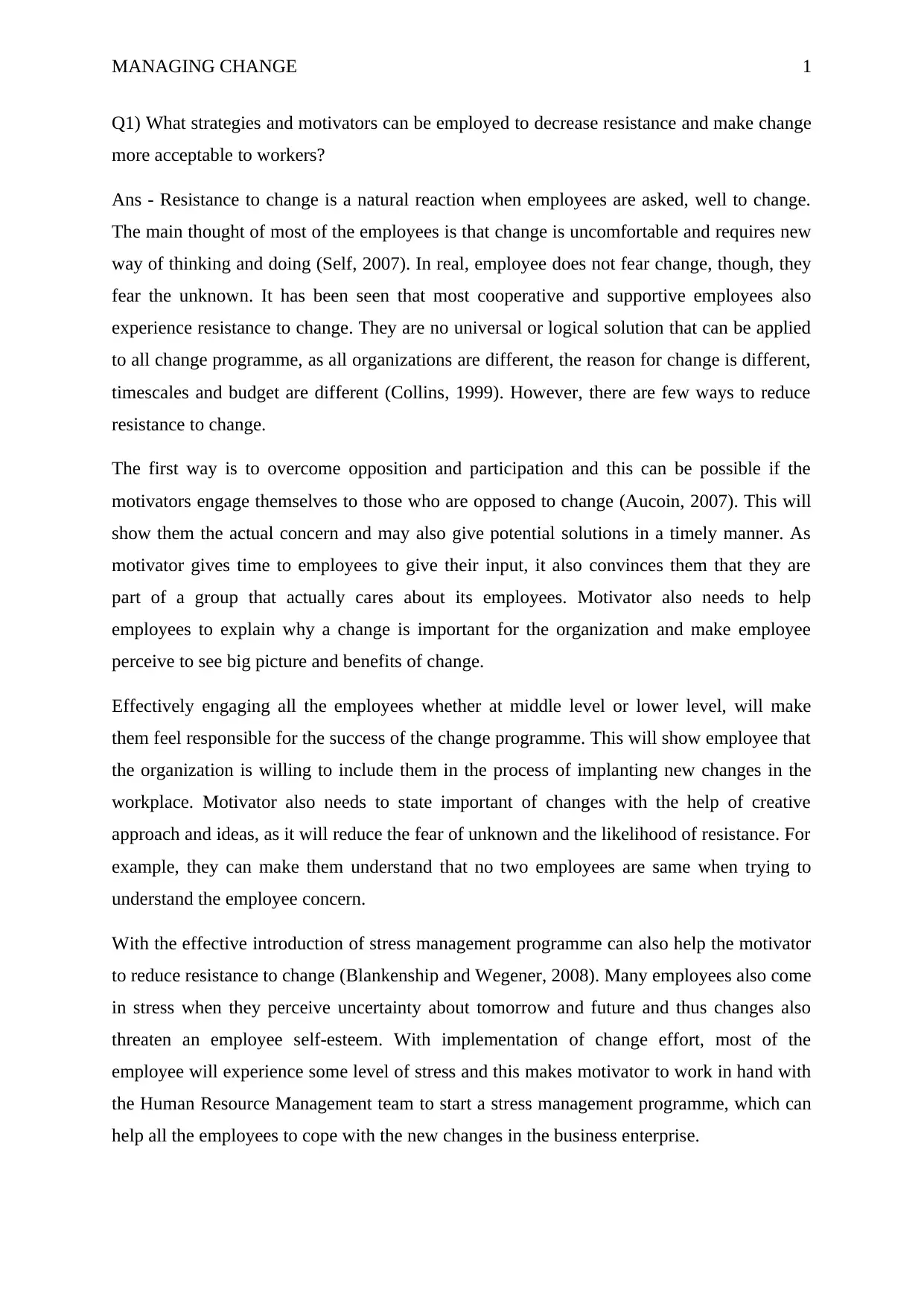
MANAGING CHANGE 1
Q1) What strategies and motivators can be employed to decrease resistance and make change
more acceptable to workers?
Ans - Resistance to change is a natural reaction when employees are asked, well to change.
The main thought of most of the employees is that change is uncomfortable and requires new
way of thinking and doing (Self, 2007). In real, employee does not fear change, though, they
fear the unknown. It has been seen that most cooperative and supportive employees also
experience resistance to change. They are no universal or logical solution that can be applied
to all change programme, as all organizations are different, the reason for change is different,
timescales and budget are different (Collins, 1999). However, there are few ways to reduce
resistance to change.
The first way is to overcome opposition and participation and this can be possible if the
motivators engage themselves to those who are opposed to change (Aucoin, 2007). This will
show them the actual concern and may also give potential solutions in a timely manner. As
motivator gives time to employees to give their input, it also convinces them that they are
part of a group that actually cares about its employees. Motivator also needs to help
employees to explain why a change is important for the organization and make employee
perceive to see big picture and benefits of change.
Effectively engaging all the employees whether at middle level or lower level, will make
them feel responsible for the success of the change programme. This will show employee that
the organization is willing to include them in the process of implanting new changes in the
workplace. Motivator also needs to state important of changes with the help of creative
approach and ideas, as it will reduce the fear of unknown and the likelihood of resistance. For
example, they can make them understand that no two employees are same when trying to
understand the employee concern.
With the effective introduction of stress management programme can also help the motivator
to reduce resistance to change (Blankenship and Wegener, 2008). Many employees also come
in stress when they perceive uncertainty about tomorrow and future and thus changes also
threaten an employee self-esteem. With implementation of change effort, most of the
employee will experience some level of stress and this makes motivator to work in hand with
the Human Resource Management team to start a stress management programme, which can
help all the employees to cope with the new changes in the business enterprise.
Q1) What strategies and motivators can be employed to decrease resistance and make change
more acceptable to workers?
Ans - Resistance to change is a natural reaction when employees are asked, well to change.
The main thought of most of the employees is that change is uncomfortable and requires new
way of thinking and doing (Self, 2007). In real, employee does not fear change, though, they
fear the unknown. It has been seen that most cooperative and supportive employees also
experience resistance to change. They are no universal or logical solution that can be applied
to all change programme, as all organizations are different, the reason for change is different,
timescales and budget are different (Collins, 1999). However, there are few ways to reduce
resistance to change.
The first way is to overcome opposition and participation and this can be possible if the
motivators engage themselves to those who are opposed to change (Aucoin, 2007). This will
show them the actual concern and may also give potential solutions in a timely manner. As
motivator gives time to employees to give their input, it also convinces them that they are
part of a group that actually cares about its employees. Motivator also needs to help
employees to explain why a change is important for the organization and make employee
perceive to see big picture and benefits of change.
Effectively engaging all the employees whether at middle level or lower level, will make
them feel responsible for the success of the change programme. This will show employee that
the organization is willing to include them in the process of implanting new changes in the
workplace. Motivator also needs to state important of changes with the help of creative
approach and ideas, as it will reduce the fear of unknown and the likelihood of resistance. For
example, they can make them understand that no two employees are same when trying to
understand the employee concern.
With the effective introduction of stress management programme can also help the motivator
to reduce resistance to change (Blankenship and Wegener, 2008). Many employees also come
in stress when they perceive uncertainty about tomorrow and future and thus changes also
threaten an employee self-esteem. With implementation of change effort, most of the
employee will experience some level of stress and this makes motivator to work in hand with
the Human Resource Management team to start a stress management programme, which can
help all the employees to cope with the new changes in the business enterprise.
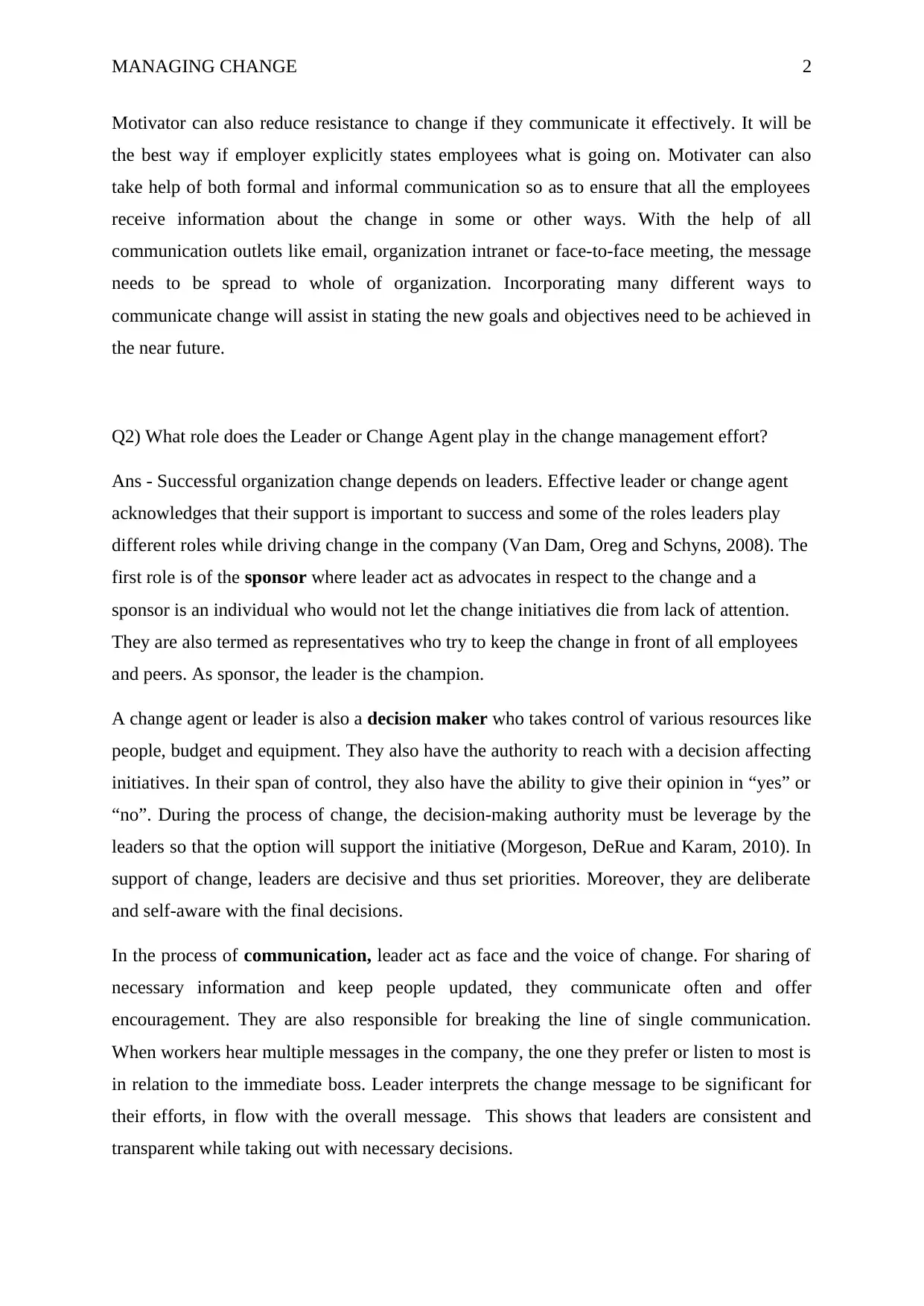
MANAGING CHANGE 2
Motivator can also reduce resistance to change if they communicate it effectively. It will be
the best way if employer explicitly states employees what is going on. Motivater can also
take help of both formal and informal communication so as to ensure that all the employees
receive information about the change in some or other ways. With the help of all
communication outlets like email, organization intranet or face-to-face meeting, the message
needs to be spread to whole of organization. Incorporating many different ways to
communicate change will assist in stating the new goals and objectives need to be achieved in
the near future.
Q2) What role does the Leader or Change Agent play in the change management effort?
Ans - Successful organization change depends on leaders. Effective leader or change agent
acknowledges that their support is important to success and some of the roles leaders play
different roles while driving change in the company (Van Dam, Oreg and Schyns, 2008). The
first role is of the sponsor where leader act as advocates in respect to the change and a
sponsor is an individual who would not let the change initiatives die from lack of attention.
They are also termed as representatives who try to keep the change in front of all employees
and peers. As sponsor, the leader is the champion.
A change agent or leader is also a decision maker who takes control of various resources like
people, budget and equipment. They also have the authority to reach with a decision affecting
initiatives. In their span of control, they also have the ability to give their opinion in “yes” or
“no”. During the process of change, the decision-making authority must be leverage by the
leaders so that the option will support the initiative (Morgeson, DeRue and Karam, 2010). In
support of change, leaders are decisive and thus set priorities. Moreover, they are deliberate
and self-aware with the final decisions.
In the process of communication, leader act as face and the voice of change. For sharing of
necessary information and keep people updated, they communicate often and offer
encouragement. They are also responsible for breaking the line of single communication.
When workers hear multiple messages in the company, the one they prefer or listen to most is
in relation to the immediate boss. Leader interprets the change message to be significant for
their efforts, in flow with the overall message. This shows that leaders are consistent and
transparent while taking out with necessary decisions.
Motivator can also reduce resistance to change if they communicate it effectively. It will be
the best way if employer explicitly states employees what is going on. Motivater can also
take help of both formal and informal communication so as to ensure that all the employees
receive information about the change in some or other ways. With the help of all
communication outlets like email, organization intranet or face-to-face meeting, the message
needs to be spread to whole of organization. Incorporating many different ways to
communicate change will assist in stating the new goals and objectives need to be achieved in
the near future.
Q2) What role does the Leader or Change Agent play in the change management effort?
Ans - Successful organization change depends on leaders. Effective leader or change agent
acknowledges that their support is important to success and some of the roles leaders play
different roles while driving change in the company (Van Dam, Oreg and Schyns, 2008). The
first role is of the sponsor where leader act as advocates in respect to the change and a
sponsor is an individual who would not let the change initiatives die from lack of attention.
They are also termed as representatives who try to keep the change in front of all employees
and peers. As sponsor, the leader is the champion.
A change agent or leader is also a decision maker who takes control of various resources like
people, budget and equipment. They also have the authority to reach with a decision affecting
initiatives. In their span of control, they also have the ability to give their opinion in “yes” or
“no”. During the process of change, the decision-making authority must be leverage by the
leaders so that the option will support the initiative (Morgeson, DeRue and Karam, 2010). In
support of change, leaders are decisive and thus set priorities. Moreover, they are deliberate
and self-aware with the final decisions.
In the process of communication, leader act as face and the voice of change. For sharing of
necessary information and keep people updated, they communicate often and offer
encouragement. They are also responsible for breaking the line of single communication.
When workers hear multiple messages in the company, the one they prefer or listen to most is
in relation to the immediate boss. Leader interprets the change message to be significant for
their efforts, in flow with the overall message. This shows that leaders are consistent and
transparent while taking out with necessary decisions.
⊘ This is a preview!⊘
Do you want full access?
Subscribe today to unlock all pages.

Trusted by 1+ million students worldwide
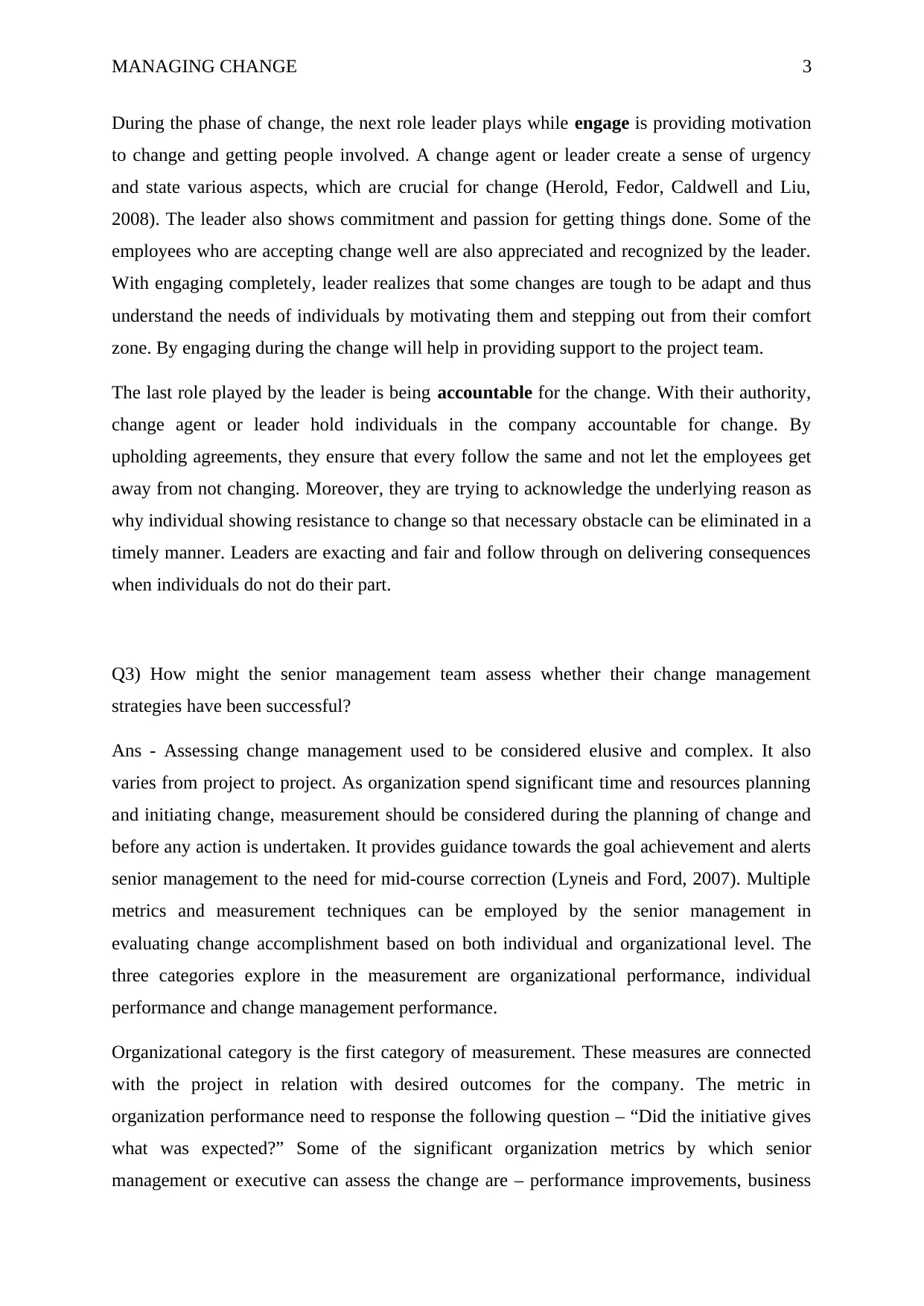
MANAGING CHANGE 3
During the phase of change, the next role leader plays while engage is providing motivation
to change and getting people involved. A change agent or leader create a sense of urgency
and state various aspects, which are crucial for change (Herold, Fedor, Caldwell and Liu,
2008). The leader also shows commitment and passion for getting things done. Some of the
employees who are accepting change well are also appreciated and recognized by the leader.
With engaging completely, leader realizes that some changes are tough to be adapt and thus
understand the needs of individuals by motivating them and stepping out from their comfort
zone. By engaging during the change will help in providing support to the project team.
The last role played by the leader is being accountable for the change. With their authority,
change agent or leader hold individuals in the company accountable for change. By
upholding agreements, they ensure that every follow the same and not let the employees get
away from not changing. Moreover, they are trying to acknowledge the underlying reason as
why individual showing resistance to change so that necessary obstacle can be eliminated in a
timely manner. Leaders are exacting and fair and follow through on delivering consequences
when individuals do not do their part.
Q3) How might the senior management team assess whether their change management
strategies have been successful?
Ans - Assessing change management used to be considered elusive and complex. It also
varies from project to project. As organization spend significant time and resources planning
and initiating change, measurement should be considered during the planning of change and
before any action is undertaken. It provides guidance towards the goal achievement and alerts
senior management to the need for mid-course correction (Lyneis and Ford, 2007). Multiple
metrics and measurement techniques can be employed by the senior management in
evaluating change accomplishment based on both individual and organizational level. The
three categories explore in the measurement are organizational performance, individual
performance and change management performance.
Organizational category is the first category of measurement. These measures are connected
with the project in relation with desired outcomes for the company. The metric in
organization performance need to response the following question – “Did the initiative gives
what was expected?” Some of the significant organization metrics by which senior
management or executive can assess the change are – performance improvements, business
During the phase of change, the next role leader plays while engage is providing motivation
to change and getting people involved. A change agent or leader create a sense of urgency
and state various aspects, which are crucial for change (Herold, Fedor, Caldwell and Liu,
2008). The leader also shows commitment and passion for getting things done. Some of the
employees who are accepting change well are also appreciated and recognized by the leader.
With engaging completely, leader realizes that some changes are tough to be adapt and thus
understand the needs of individuals by motivating them and stepping out from their comfort
zone. By engaging during the change will help in providing support to the project team.
The last role played by the leader is being accountable for the change. With their authority,
change agent or leader hold individuals in the company accountable for change. By
upholding agreements, they ensure that every follow the same and not let the employees get
away from not changing. Moreover, they are trying to acknowledge the underlying reason as
why individual showing resistance to change so that necessary obstacle can be eliminated in a
timely manner. Leaders are exacting and fair and follow through on delivering consequences
when individuals do not do their part.
Q3) How might the senior management team assess whether their change management
strategies have been successful?
Ans - Assessing change management used to be considered elusive and complex. It also
varies from project to project. As organization spend significant time and resources planning
and initiating change, measurement should be considered during the planning of change and
before any action is undertaken. It provides guidance towards the goal achievement and alerts
senior management to the need for mid-course correction (Lyneis and Ford, 2007). Multiple
metrics and measurement techniques can be employed by the senior management in
evaluating change accomplishment based on both individual and organizational level. The
three categories explore in the measurement are organizational performance, individual
performance and change management performance.
Organizational category is the first category of measurement. These measures are connected
with the project in relation with desired outcomes for the company. The metric in
organization performance need to response the following question – “Did the initiative gives
what was expected?” Some of the significant organization metrics by which senior
management or executive can assess the change are – performance improvements, business
Paraphrase This Document
Need a fresh take? Get an instant paraphrase of this document with our AI Paraphraser
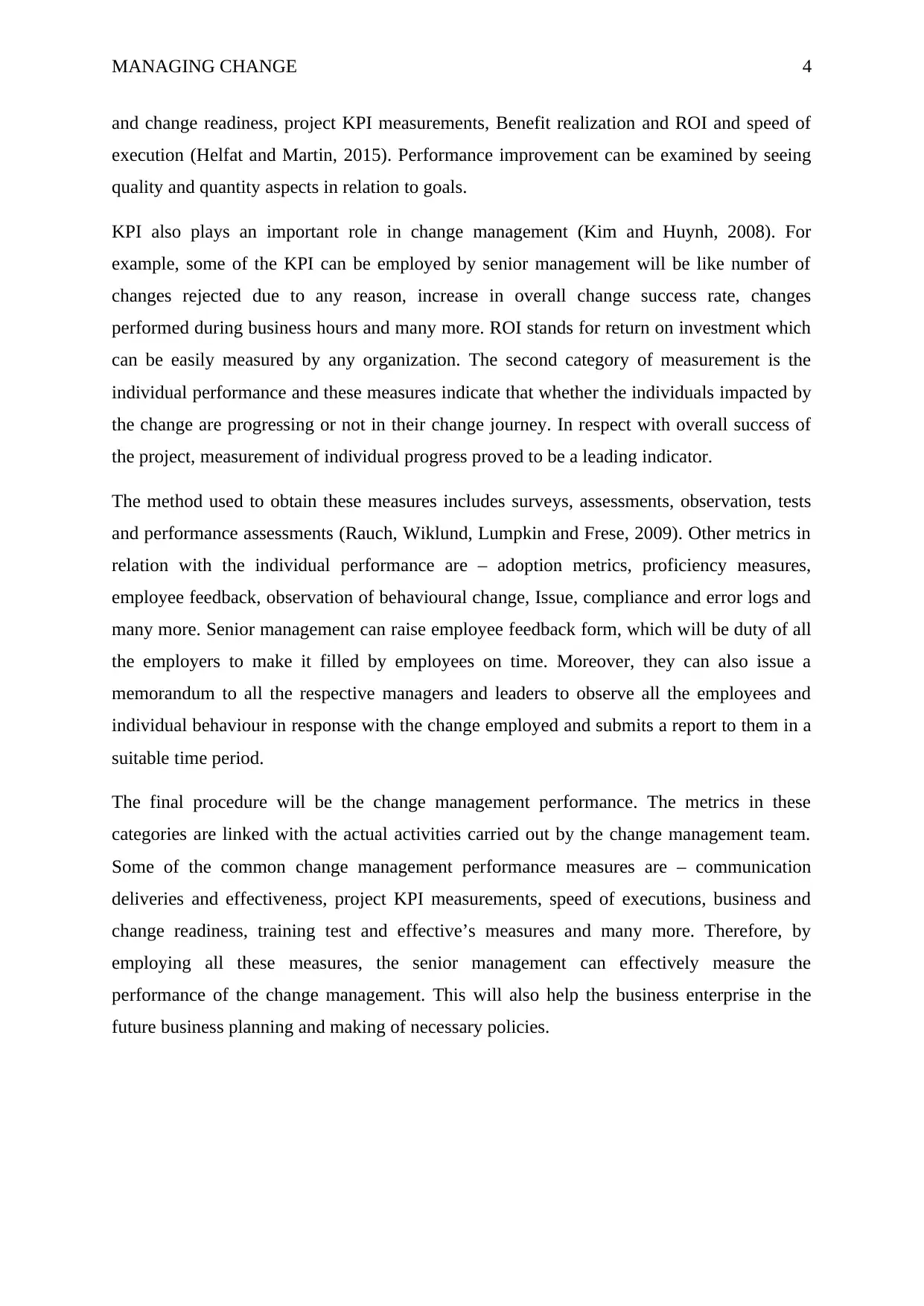
MANAGING CHANGE 4
and change readiness, project KPI measurements, Benefit realization and ROI and speed of
execution (Helfat and Martin, 2015). Performance improvement can be examined by seeing
quality and quantity aspects in relation to goals.
KPI also plays an important role in change management (Kim and Huynh, 2008). For
example, some of the KPI can be employed by senior management will be like number of
changes rejected due to any reason, increase in overall change success rate, changes
performed during business hours and many more. ROI stands for return on investment which
can be easily measured by any organization. The second category of measurement is the
individual performance and these measures indicate that whether the individuals impacted by
the change are progressing or not in their change journey. In respect with overall success of
the project, measurement of individual progress proved to be a leading indicator.
The method used to obtain these measures includes surveys, assessments, observation, tests
and performance assessments (Rauch, Wiklund, Lumpkin and Frese, 2009). Other metrics in
relation with the individual performance are – adoption metrics, proficiency measures,
employee feedback, observation of behavioural change, Issue, compliance and error logs and
many more. Senior management can raise employee feedback form, which will be duty of all
the employers to make it filled by employees on time. Moreover, they can also issue a
memorandum to all the respective managers and leaders to observe all the employees and
individual behaviour in response with the change employed and submits a report to them in a
suitable time period.
The final procedure will be the change management performance. The metrics in these
categories are linked with the actual activities carried out by the change management team.
Some of the common change management performance measures are – communication
deliveries and effectiveness, project KPI measurements, speed of executions, business and
change readiness, training test and effective’s measures and many more. Therefore, by
employing all these measures, the senior management can effectively measure the
performance of the change management. This will also help the business enterprise in the
future business planning and making of necessary policies.
and change readiness, project KPI measurements, Benefit realization and ROI and speed of
execution (Helfat and Martin, 2015). Performance improvement can be examined by seeing
quality and quantity aspects in relation to goals.
KPI also plays an important role in change management (Kim and Huynh, 2008). For
example, some of the KPI can be employed by senior management will be like number of
changes rejected due to any reason, increase in overall change success rate, changes
performed during business hours and many more. ROI stands for return on investment which
can be easily measured by any organization. The second category of measurement is the
individual performance and these measures indicate that whether the individuals impacted by
the change are progressing or not in their change journey. In respect with overall success of
the project, measurement of individual progress proved to be a leading indicator.
The method used to obtain these measures includes surveys, assessments, observation, tests
and performance assessments (Rauch, Wiklund, Lumpkin and Frese, 2009). Other metrics in
relation with the individual performance are – adoption metrics, proficiency measures,
employee feedback, observation of behavioural change, Issue, compliance and error logs and
many more. Senior management can raise employee feedback form, which will be duty of all
the employers to make it filled by employees on time. Moreover, they can also issue a
memorandum to all the respective managers and leaders to observe all the employees and
individual behaviour in response with the change employed and submits a report to them in a
suitable time period.
The final procedure will be the change management performance. The metrics in these
categories are linked with the actual activities carried out by the change management team.
Some of the common change management performance measures are – communication
deliveries and effectiveness, project KPI measurements, speed of executions, business and
change readiness, training test and effective’s measures and many more. Therefore, by
employing all these measures, the senior management can effectively measure the
performance of the change management. This will also help the business enterprise in the
future business planning and making of necessary policies.
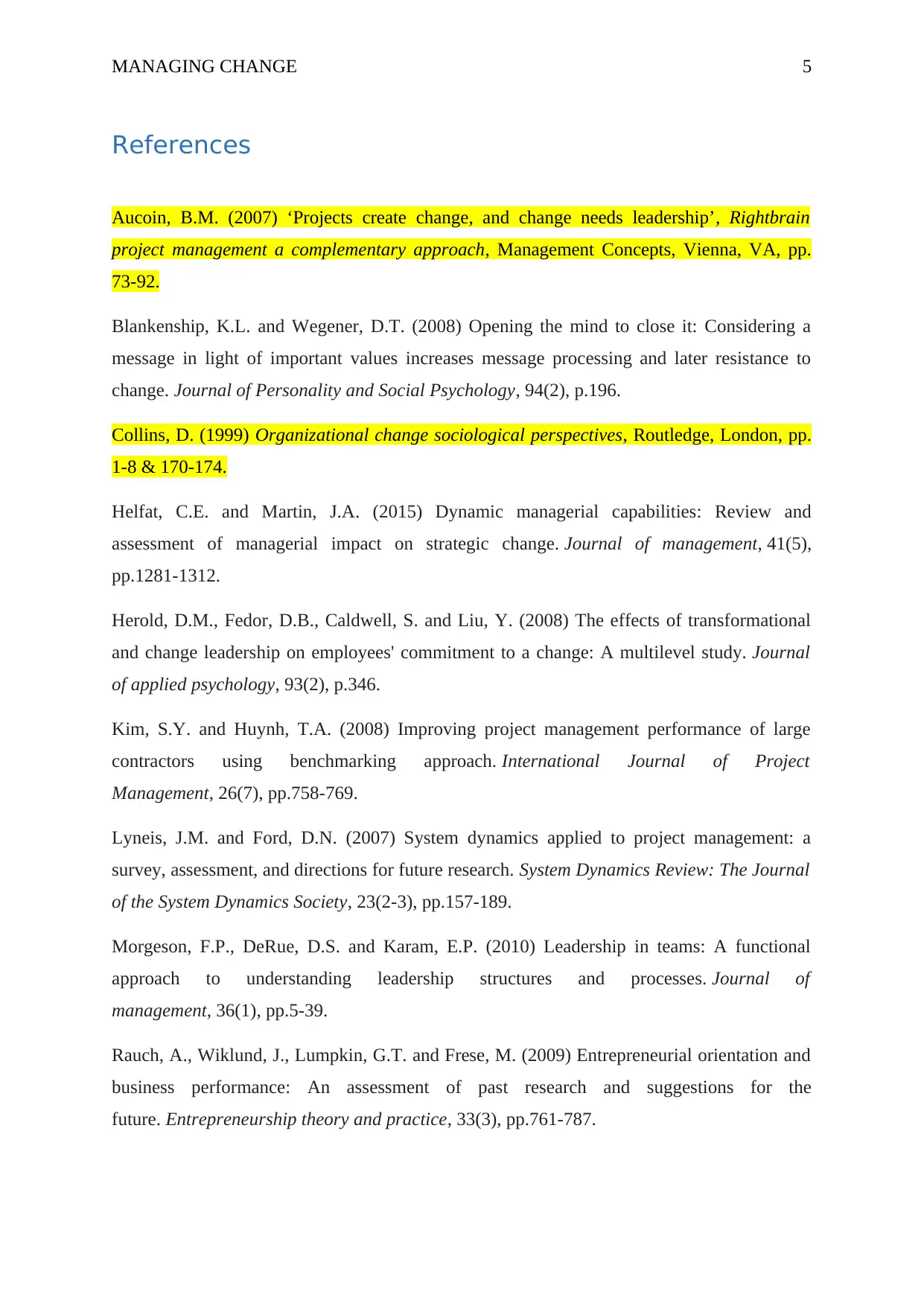
MANAGING CHANGE 5
References
Aucoin, B.M. (2007) ‘Projects create change, and change needs leadership’, Rightbrain
project management a complementary approach, Management Concepts, Vienna, VA, pp.
73-92.
Blankenship, K.L. and Wegener, D.T. (2008) Opening the mind to close it: Considering a
message in light of important values increases message processing and later resistance to
change. Journal of Personality and Social Psychology, 94(2), p.196.
Collins, D. (1999) Organizational change sociological perspectives, Routledge, London, pp.
1-8 & 170-174.
Helfat, C.E. and Martin, J.A. (2015) Dynamic managerial capabilities: Review and
assessment of managerial impact on strategic change. Journal of management, 41(5),
pp.1281-1312.
Herold, D.M., Fedor, D.B., Caldwell, S. and Liu, Y. (2008) The effects of transformational
and change leadership on employees' commitment to a change: A multilevel study. Journal
of applied psychology, 93(2), p.346.
Kim, S.Y. and Huynh, T.A. (2008) Improving project management performance of large
contractors using benchmarking approach. International Journal of Project
Management, 26(7), pp.758-769.
Lyneis, J.M. and Ford, D.N. (2007) System dynamics applied to project management: a
survey, assessment, and directions for future research. System Dynamics Review: The Journal
of the System Dynamics Society, 23(2‐3), pp.157-189.
Morgeson, F.P., DeRue, D.S. and Karam, E.P. (2010) Leadership in teams: A functional
approach to understanding leadership structures and processes. Journal of
management, 36(1), pp.5-39.
Rauch, A., Wiklund, J., Lumpkin, G.T. and Frese, M. (2009) Entrepreneurial orientation and
business performance: An assessment of past research and suggestions for the
future. Entrepreneurship theory and practice, 33(3), pp.761-787.
References
Aucoin, B.M. (2007) ‘Projects create change, and change needs leadership’, Rightbrain
project management a complementary approach, Management Concepts, Vienna, VA, pp.
73-92.
Blankenship, K.L. and Wegener, D.T. (2008) Opening the mind to close it: Considering a
message in light of important values increases message processing and later resistance to
change. Journal of Personality and Social Psychology, 94(2), p.196.
Collins, D. (1999) Organizational change sociological perspectives, Routledge, London, pp.
1-8 & 170-174.
Helfat, C.E. and Martin, J.A. (2015) Dynamic managerial capabilities: Review and
assessment of managerial impact on strategic change. Journal of management, 41(5),
pp.1281-1312.
Herold, D.M., Fedor, D.B., Caldwell, S. and Liu, Y. (2008) The effects of transformational
and change leadership on employees' commitment to a change: A multilevel study. Journal
of applied psychology, 93(2), p.346.
Kim, S.Y. and Huynh, T.A. (2008) Improving project management performance of large
contractors using benchmarking approach. International Journal of Project
Management, 26(7), pp.758-769.
Lyneis, J.M. and Ford, D.N. (2007) System dynamics applied to project management: a
survey, assessment, and directions for future research. System Dynamics Review: The Journal
of the System Dynamics Society, 23(2‐3), pp.157-189.
Morgeson, F.P., DeRue, D.S. and Karam, E.P. (2010) Leadership in teams: A functional
approach to understanding leadership structures and processes. Journal of
management, 36(1), pp.5-39.
Rauch, A., Wiklund, J., Lumpkin, G.T. and Frese, M. (2009) Entrepreneurial orientation and
business performance: An assessment of past research and suggestions for the
future. Entrepreneurship theory and practice, 33(3), pp.761-787.
⊘ This is a preview!⊘
Do you want full access?
Subscribe today to unlock all pages.

Trusted by 1+ million students worldwide
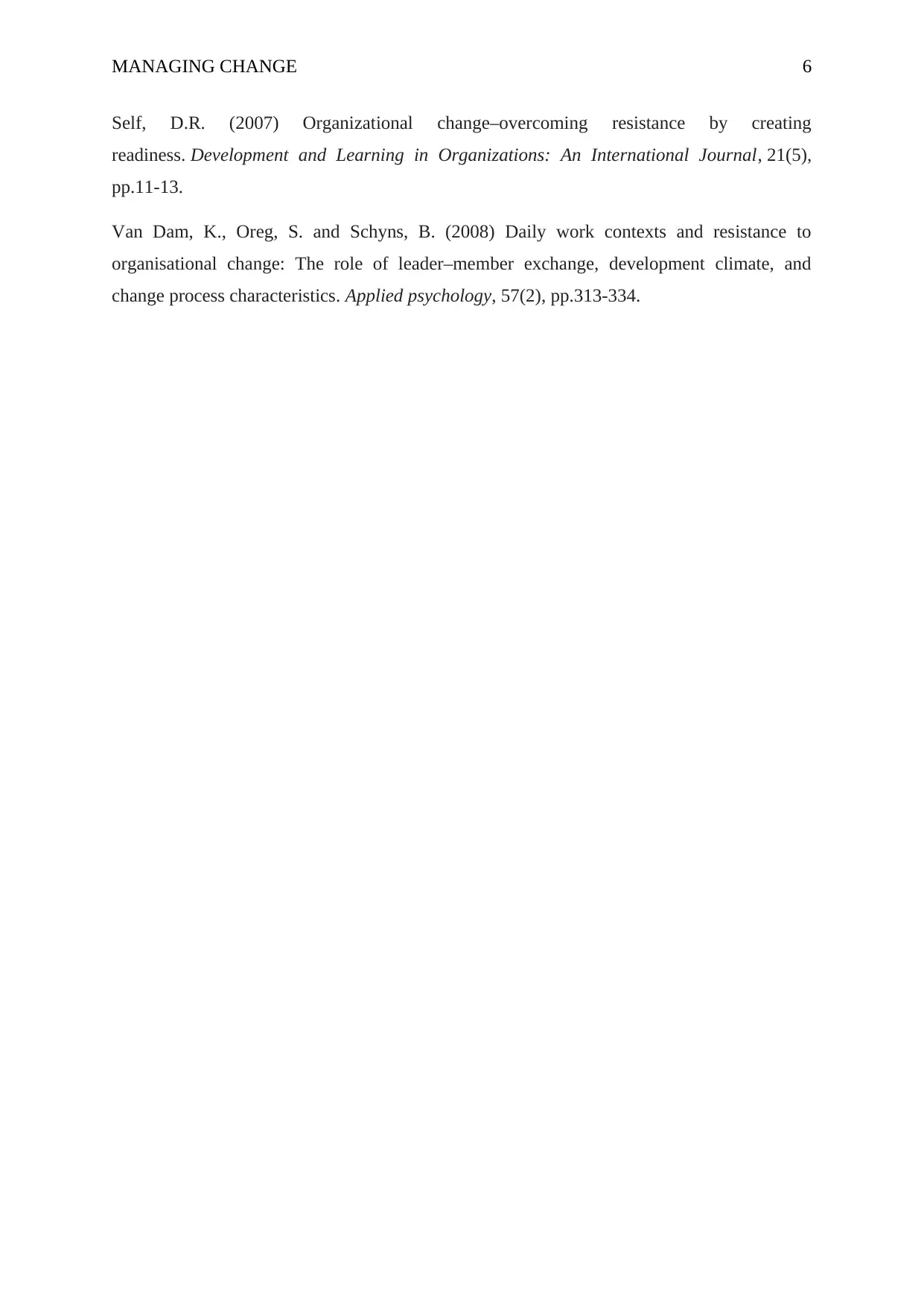
MANAGING CHANGE 6
Self, D.R. (2007) Organizational change–overcoming resistance by creating
readiness. Development and Learning in Organizations: An International Journal, 21(5),
pp.11-13.
Van Dam, K., Oreg, S. and Schyns, B. (2008) Daily work contexts and resistance to
organisational change: The role of leader–member exchange, development climate, and
change process characteristics. Applied psychology, 57(2), pp.313-334.
Self, D.R. (2007) Organizational change–overcoming resistance by creating
readiness. Development and Learning in Organizations: An International Journal, 21(5),
pp.11-13.
Van Dam, K., Oreg, S. and Schyns, B. (2008) Daily work contexts and resistance to
organisational change: The role of leader–member exchange, development climate, and
change process characteristics. Applied psychology, 57(2), pp.313-334.
1 out of 7
Related Documents
Your All-in-One AI-Powered Toolkit for Academic Success.
+13062052269
info@desklib.com
Available 24*7 on WhatsApp / Email
![[object Object]](/_next/static/media/star-bottom.7253800d.svg)
Unlock your academic potential
Copyright © 2020–2025 A2Z Services. All Rights Reserved. Developed and managed by ZUCOL.





